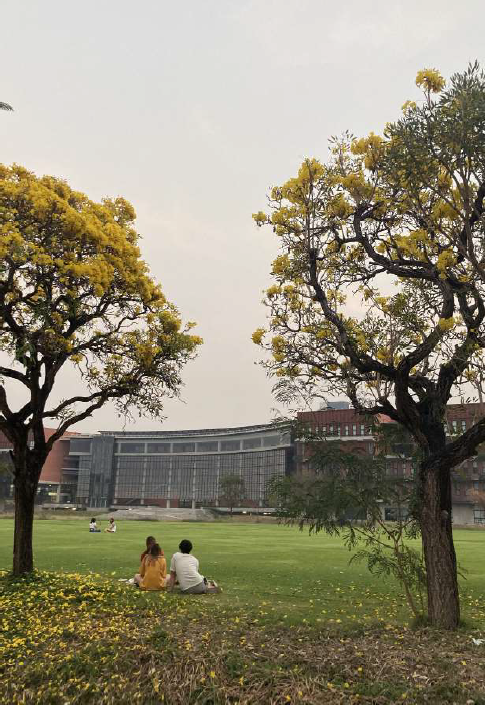Classifying essential morphological characteristics in campus town: a case study of Thammasat University (Rangsit campus)
Keywords:
urban morphology, campus town, Geographic Information System (GIS), Space SyntaxAbstract
Campus town is the center of learning society because it promotes sustainable urban development concepts, particularly as a source of knowledge, jobs, trades and services. Furthermore, the campus town is a shared living space for a diverse group of people. The contexts and elements of the campus town and its surrounding communities contribute to a one-of-a-kind urban environment that results in a one-of-a-kind neighbourhood. This paper is aimed to categorise and identify the urban morphological characteristics of campus town which were used Thammasat University (Rangsit campus) and its surrounding area within a 3-kilometer radius as research areas. The research methodology is based on a survey of physical characteristics as well as an examination of important morphological elements such land use, building use, and transit network utilising spatial analysis tools using Geographic Information System (GIS) and Space Syntax. According to the findings, the morphological characteristics of Thammasat University (Rangsit Campus) town were classified into four distinct districts, (1) the centre of education and research zone, which has the capacity to serve as a hub for knowledge, training, and service provider of public utilities and facilities, (2) the industrial zone, which is a cluster of buildings used for industry with a focus on building usage, (3) the community zone, which is made up of residential villages influenced by expanding from Bangkok to the perimeter sector and (4) the agricultural zone, which is an open field for agriculture, quiet, peaceful and natural. The findings of this study can be used as a guideline for policy-making to promote Thammasat University’s long-term development (Rangsit campus) leading to efficient space management and planning that is consistent with people’s lifestyles and the city.
References
Abu-Ghazzeh, T.M. (1999). Communicating behavioral research to campus design: factors affecting the perception and use of outdoor spaces at the University of Jordan. Environment and Behavior journal, 31(6), 764-804.
Boonyachat, S., Chunnasit, B. & Chumjit, S. (2002). Naew tang nai karn kamnot rubbab mueang mahawitthayalai khong prathet Thai (rayathi 1-2). (In Thai) [Guidelines for defining a university city in Thailand (Phases 1-2)]. Bangkok: King Mongkut’s University of Technology Thonburi Press.
Center of Innovative Design and Research. (2019). Rai ngan chabap sombun kongkarn wang phang maebot mahawitthayalai Thammasat 2577. (In Thai) [A final report of Thammasat University master plan 2577]. Pathumthani: Thammasat University Press.
Conzen, M.R.G. (1969). Alnwick, Northumberland: a study in town-plan analysis. Oxford: Alden Press.
Hiller, B. & Hanson, J. (1984). The social logic of space. United Kingdom: Cambridge University Press.
Iamtrakul, P. & Klaylee, J. (2018). Sustaining road safety for campus town development: case study of Thammasat University (Rangsit campus). Journal of Architectural/Planning Research and Studies, 15(1), 49-68.
Kongphunphin, C., Ruangrattanaumporn, I. & Iamtrakul, P. (2015). Karn phatthana chumchon mahawitthayalai hai kerd khwam plotphai thang thanon yang yangyuen. (In Thai) [Sustainable road safety towards campus town development]. In Thaneerananont, P. (Ed.). Proceeding of karn khonsong haeng chat. (In Thai) [The 10th national transport conference] (pp. 114-124). Bangkok: Siam Printing.
Kongphunphin, C. & Srivanit, M. (2021). Classifying essential morphological characteristics to understanding urbanity in the old town of Chiang Mai. In Kang, T. & Lee, Y. (Ed.). Proceedings of 2021 4th International Conference on Civil Engineering and Architecture (pp.413-423). New York: Springer.
Marcus, C.C. & Francis, C. (1998). People place: design guidelines for urban open space. New York: John Wiley and Sons Press.
Mohammed, A., Ukai, T. & Hal, M. (2022). Towards a sustainable campus-city relationship: a systematic review of the literature. Regional Sustainability, 3(1), 53-67.
Moudon, A.V. (1997). Urban morphology as an emerging interdisciplinary field. Urban Morphology, 1(1), 3–10.
Ojeda, O. & Yudell, M. (1997). Campus and community english dictionary, 1989. Oxford: Oxford University Press.
Phathumtani office of Public Works and Town & Country Planning. (2021). Land use and building use data. PhathumThani: Author.
Rashid, M. (2019). Space syntax: a network-based configurational approach to studying urban morphology. Basel: Birkhäuser Press.
Saengsawang, C. (2009). Rabop sanapsanun phuea karn anurak lae fuenfu mueang. (In Thai) [Support system for urban conservation and rehabilitation]. Academic Journal of Architecture, 2, 141-148.
Sangsehanat, S. (2018). Khrongkan attalak thang santhanwitthaya khong mueang Krungthep. (In Thai) [Morphological identity of Bangkok]. Bangkok: Thailand Research Fund.
Srivanit, M., Kongphunphin, C. & Rinchumphu, D. (2022). Exploring the association of spatial capital and economic diversity in the tourist city of Surat Thani, Thailand. Internationl Journal of Geo-Information, 11(10), 507-524
Ye, Y. & Nes, A.V. (2014). Quantitative tools in urban morphology: combining space syntax, spacematric and mixed-use index in a GIS framework. Urban Morphology, 18(2), 97-118.

Downloads
Published
Issue
Section
License
Copyright (c) 2023 Faculty of Architecture, Chiang Mai University

This work is licensed under a Creative Commons Attribution-NonCommercial-NoDerivatives 4.0 International License.


